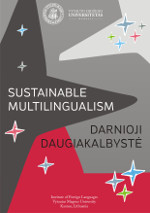PECULIARITIES OF TEACHING AND LEARNING OF NEW IMMIGRANT PUPILS: ESTONIAN CASE
PECULIARITIES OF TEACHING AND LEARNING OF NEW IMMIGRANT PUPILS: ESTONIAN CASE
Author(s): Elvira KüünSubject(s): Foreign languages learning, Applied Linguistics, Sociolinguistics
Published by: Vytauto Didžiojo Universitetas
Keywords: Estonian;immigration;multicultural class;other languages;teaching methods
Summary/Abstract: Estonia has been part of the European Union since 2004. Concerning that, it is very important for Estonia as a Member State of the EU to find out what languages are used by Estonian residents in informal and formal situations and environments (DfEE). In the context of globalisation, the topic of immigrants in Estonia and their educational needs, linguistic and cultural specificities have also gained more and more importance. Apart from that, attention must be paid to the skill of coping with the changed situation at the level of the society and the individual, while maintaining the immigrants’ cultural identity and at the same time integrating them effectively into the Estonian cultural space. An important role in this is played by the education system. The Estonian public education curriculum (National curriculum for basic schools ..., 2010; National curriculum for upper secondary schools ..., 2010) promotes Estonian culture, common European values, multiculturalism and the cultural and scientific achievements of the world. The research at hand reflects Estonia’s first experiences in that field. The research method used was unstructured in-depth interviews. The research results show that the state provides financial support for the education of new immigrant students, the school attempts to ensure a smooth adjustment of the students, although academic performance and the language level of the new immigrants are very different, the new immigrants generally cope linguistically and have mostly adjusted well, i.e. they have learned the Estonian language and have received peer and teacher support in the educational process. However, the instruction of the home language of the ethnic minority is left to the family.
Journal: Darnioji daugiakalbystė
- Issue Year: 2016
- Issue No: 8
- Page Range: 144-164
- Page Count: 21
- Language: English

